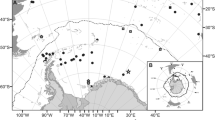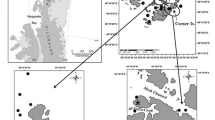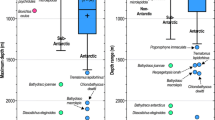Abstract
Antarctic notothenioid fish larvae and juveniles are pelagic and subject to oceanic transport, influencing species distribution and biogeography. The nature of notothenioid larval/juvenile diversity in the high-latitude McMurdo Sound is virtually unknown to-date. We report here a first assessment of this diversity and its contribution to species richness in the Sound. We collected 151 larvae and juveniles from under ice cover. To overcome uncertainties in identifying larvae by morphology, we used full-length mitochondrial ND2 gene sequences in phylogenetic reconstruction with reference adults and identified 13 species representing four families. Six are nototheniids whose adults are common in the Sound, and a seventh is a cryptic nototheniid that is likely Pagothenia brachysoma, previously unknown to the Sound. The rest included four icefishes, an artedidraconid, and a bathydraconid, all without prior adult record in the Sound. With seven of 13 species previously undocumented, larval/juvenile notothenioid diversity appears to double adult diversity. Published fish surveys show adults of these icefishes and the artedidraconid occur in the nearby Terra Nova Bay and/or western Ross Sea; thus, their pelagic larvae and juveniles could be transported by the Ross Sea circulation into the Sound. The bathydraconid, identified as Psilodraco breviceps, is reportedly endemic to S. Georgia. We found additional unpublished barcode sequences for specimens from the Dumont d’Urville Sea and Ross Sea, and they form a species clade with the McMurdo larval and Marguerite Bay adult P. breviceps in this study, indicating this species has a circumpolar distribution.





Similar content being viewed by others
References
Balushkin AV, Spodareva VV (2013) Pogonophryne sarmentifera sp. nov. (Artedidraconidae; Notothenioidei; Perciformes)—the deep-water species of Antarctic plunderfishes from the Ross Sea (Southern Ocean). Trudy Zoologicheskogo Instituta 317:275–281
Balushkin AV, Petrov AF, Prutko VG (2010) Pogonophryne brevibarbata sp. nov. (Artedidraconidae, Notothenioidei, Perciformes)—a new species of toadlike plunderfish from the Ross Sea, Antarctica. Trudy Zoologicheskogo Instituta 314:381–386
Barry JP, Dayton PK (1988) Current patterns in McMurdo Sound, Antarctica and their relationship to local biotic communities. Polar Biol 8:367–376
Buckley PA (2013) Rapid change in shallow water fish species composition in a historically stable Antarctic environment. Antarct Sci 25:676–680
Cheng C-HC, Chen L, Near TJ, Jin Y (2003) Functional antifreeze glycoprotein genes in temperate-water New Zealand nototheniid fish infer an Antarctic evolutionary origin. Mol Biol Evol 20:1897–1908
Clark MR, Dunn MR, McMillan PJ, Pinkerton MH, Stewart A, Hanchet SM (2010) Latitudinal variation of demersal fish assemblages in the western Ross Sea. Antarct Sci 22:782–792
Cziko PA, Cheng C-HC (2006) A new species of nototheniid (Perciformes: Notothenioidei) fish from McMurdo Sound, Antarctica. Copeia 4:752–759
Cziko PA, Evans CW, Cheng C-HC, DeVries AL (2006) Freezing resistance of antifreeze-deficient larval Antarctic fish. J Exp Biol 209:407–420
Damerau M, Matschiner M, Salzburger W, Hanel R (2012) Comparative population genetics of seven notothenioid fish species reveals high levels of gene flow along ocean currents in the southern Scotia Arc. Antarct Polar Biol 35:1073–1086
Darriba D, Taboada GL, Doallo R, Posada D (2012) jModelTest 2: more models, new heuristics and parallel computing. Nat Methods 9:772
Dettai A et al (2011) The actinopterygian diversity of the CEAMARC cruises: barcoding and molecular taxonomy as a multi-level tool for new findings. Deep Sea Res Part II 58:250–263. doi:10.1016/j.dsr2.2010.05.021
Dettai A, Berkani M, Lautredou A-C, Couloux A, Lecointre G, Ozouf-Costaz C, Gallut C (2012) Tracking the elusive monophyly of nototheniid fishes (Teleostei) with multiple mitochondrial and nuclear markers. Mar Genomics 8:49–58
DeWitt HH (1970) The character of the midwater fish fauna of the Ross Sea, Antarctica. In: Holdgate W (ed) Antarctic ecology. Academic Press, London, pp 305–315
DeWitt HH, Tyler JC (1960) Fishes of the Stanford Antarctic Biological Research Program, 1958–1959. Stanford Ichthyol Bull 7:162–199
DeWitt HH, Heemstra PC, Gon O (1990) Nototheniidae. In: Heemstra PC, Gon O (eds) Fishes of the Southern Ocean. JLB Smith Institute of Ichthyology, Grahamstown, pp 279–331
Donnelly J, Torres JJ (2008) Pelagic fishes in the Marguerite Bay region of the West Antarctic Peninsula continental shelf. Deep Sea Res Part II 55:523–539. doi:10.1016/j.dsr2.2007.11.015
Donnelly J, Torres JJ, Sutton TT, Simoniello C (2004) Fishes of the eastern Ross Sea, Antarctica. Polar Biol 27:637–650
Eakin RR, Eastman JT (1998) New species of Pogonophryne (Pisces, Artedidraconidae) from the Ross Sea, Antarctica. Copeia 4:1005–1009
Eastman JT (1985) Pleuragramma antarcticum (Pisces, Nototheniidae) as food for other fishes in McMurdo Sound, Antarctica. Polar Biol 4:155–160
Eastman JT (1993) Antarctic fish biology: evolution in a unique environment. Academic Press Inc, San Diego
Eastman JT (2005) The nature of the diversity of Antarctic fishes. Polar Biol 28:93–107
Eastman JT, DeVries AL (1982) Buoyancy studies of notothenioid fishes in McMurdo Sound, Antarctica. Copeia 2:385–393
Eastman JT, Eakin RR (2015) Notothenioid classification and list of species. Ohio University. http://www.oucom.ohiou.edu/dbms-eastman/index.htm
Eastman JT, Hubold G (1999) The fish fauna of the Ross Sea, Antarctica. Antarct Sci 11:293–304
Edgar RC (2004) MUSCLE: multiple sequence alignment with high accuracy and high throughput. Nucleic Acids Res 32:1792–1797
Evans CW, Cziko P, Cheng C-HC, DeVries AL (2005) Spawning behaviour and early development in the naked dragonfish Gymnodraco acuticeps Antarctic. Science 17:319–327
Evans CW, Pace L, Cziko PA, Marsh AG, Cheng C-HC, DeVries AL (2006) Metabolic energy utilization during development of Antarctic naked dragonfish (Gymnodraco acuticeps). Polar Biol 29:519–525
Gon O (1990) Bathydraconidae. In: Gon O, Heemstra PC (eds) Fishes of the Southern Ocean. J. L. B. Smith Institute of Ichthyology, Grahamstown, pp 364–380
Granata A, Guglielmo L, Greco S, Vacchi M, Sidoti O, Zagami G, La Mesa M (2000) Spatial distribution and feeding habits of larval and juvenile Pleuragramma antarcticum in the Western Ross Sea (Antarctica). In: Faranda F, Guglielmo L, Lanora A (eds) Ross Sea ecology. Springer, Berlin, pp 369–393
Granata A, Cubeta A, Guglielmo L, Sidoti O, Greco S, Vacchi M, La Mesa M (2002) Ichthyoplankton abundance and distribution in the Ross Sea during 1987–1996. Polar Biol 25:187–202
Guglielmo L, Granata A, Greco S (1998) Distribution and abundance of postlarval and juvenile Pleuragramma antarcticum (Pisces, Nototheniidae) off Terra Nova Bay (Ross Sea, Antarctica). Polar Biol 19:37–51
Guindon S, Gascuel O (2003) A simple, fast and accurate method to estimate large phylogenies by maximum-likelihood. Syst Biol 52:696–704
Hanchet SM, Stewart AL, McMillan PJ, Clark MR, O’Driscoll RL, Stevenson ML (2013) Diversity, relative abundance, new locality records, and updated fish fauna of the Ross Sea region. Antarct Sci 25:619–636. doi:10.1017/S0954102012001265
Hubbs CL (1943) Terminology of early stages of fishes. Copeia 4:260
Hunt BM, Hoefling K, Cheng C-HC (2003) Annual warming episodes in seawater temperatures in McMurdo Sound in relationship to endogenous ice in notothenioid fish. Antarct Sci 15:333–338. doi:10.1017/S0954102003001342
Kawaguchi K, Ishikawa S, Matsuda O, Naito Y (1989) Tagging experiment of nototheniid fish, Trematomus bernacchii Boulenger under the coastal fast ice in Lützow-Holm Bay, Antarctica. Proc NIPR Symp Polar Biol 2:111–116
Kellerman A (1990) Catalogue of early life stages of Antarctic notothenioid fishes. Berichte für. Polarforschung 67:45–136
Kocher TD, Conroy JA, McKaye KR, Stauffer JR, Lockwood SF (1995) Evolution of NADH dehydrogenase subunit 2 in east African cichlid fish. Mol Genet Evol 4:420–432
Kock K-H (1992) Development of eggs and larvae. Antarctic fish and fisheries. University Press, Cambridge, pp 96–100
La Mesa M, Cattaneo-Vietti R, Vacchi M (2006) Species composition and distribution of the Antarctic plunderfishes (Pisces, Artedidraconidae) from the Ross Sea off Victoria Land. Deep-Sea Res II 53:1061–1070
Lecointre G et al (2013) Is the species flock concept operational? The Antarctic shelf case. PLoS One 8:e68787
Loeb V, Kellerman A, Koubbi P, North A, White M (1993) Antarctic larval fish assemblages—a review. Bull Mar Sci 53:416–449
Maddison WP, Maddison DR (2011) Mesquite: a modular system for evolutionary analysis, version 2.75, 2.75 edn. http://mesquiteproject.org
Matschiner M, Hanel R, Salzburger W (2009) Gene flow by larval dispersal in the Antarctic notothenioid fish Gobionotothen gibberifrons. Mol Ecol 18:2574–2587
Miyamoto Y, Tanimura A (1999) Behavior of the Antarctic fish Trematomus bernacchii (Pisces, Nototheniidae) beneath the sea ice near the Antarctic station Syowa using acoustic biotelemetry. Fish Sci 65:315–316
Moylan TJ, Sidell BD (2000) Concentrations of myoglobin and myoglobin mRNA in heart ventricles from Antarctic fishes. J Exp Biol 203:1277–1286
Near TJ, Cheng C-HC (2008) Phylogenetics of notothenioid fishes (Teleostei: Acanthomorpha): Inferences from mitochondrial and nuclear gene sequences. Mol Phylogenet Evol 47:832–840
Near TJ, Pesavento JJ, Cheng C-HC (2003) Mitochondrial DNA, morphology, and the phylogenetic relationships of Antarctic icefishes (Notothenioidei: Channichthyidae). Mol Phylogenet Evol 28:87–98
Near TJ, Pesavento JJ, Cheng C-HC (2004) Phylogenetic investigations of Antarctic notothenioid fishes (Perciformes: Notothenioidei) using complete gene sequences of the mitochondrial encoded 16S rRNA. Mol Phylogenet Evol 32:881–891
Near TJ et al (2012) Ancient climate change, antifreeze, and the evolutionary diversification of Antarctic fishes. Proc Natl Acad Sci 109:3434–3439. doi:10.1073/pnas.1115169109
Rickard GJ, Roberts MJ, Williams MJM, Dunn A, Smith MH (2010) Mean circulation and hydrography in the Ross Sea sector, Southern Ocean: representation in numerical models. Antarct Sci 22:533–558
Rock J, Costa FO, Walker DI, North AW, Hutchinson WF, Carvalho GR (2008) DNA barcodes of fish of the Scotia Sea, Antarctica indicate priority groups for taxonomic and systematics focus. Antarct Sci 20:253–262
Ronquist F et al (2012) MrBayes 3.2: efficient Bayesian phylogenetic inference and model choice across a large model space. Syst Biol 61:539–542
Shandikov GA, Eakin RR (2013) Pogonophryne neyelovi, a new species of Antarctic short-barbeled plunderfish (Perciformes, Notothenioidei, Artedidraconidae) from the deep Ross Sea. ZooKeys 296:59–77
Shandikov GA, Eakin RR, Usachev S (2013) Pogonophryne tronio, a new species of Antarctic short-barbeled plunderfish (Perciformes: Notothenioidei: Artedidraconidae) from the deep Ross Sea with new data on Pogonophryne brevibarbata. Polar Biol 36:273–289
Stamatakis A (2014) RAxML version 8: a tool for phylogenetic analysis and post-analysis of large phylogenies. Bioinformatics 30:1312–1313
Takahashi M, Nemoto T (1984) The food of some Antarctic fish in the western Ross Sea in summer 1979. Polar Biol 3:237–239
Tamura K, Stecher G, Peterson D, Filipski A, Kumar S (2013) MEGA6: Molecular Evolutionary Genetics Analysis version 6.0. Mol Biol Evol 30:2725–2729
Vacchi M, La Mesa M, Greco S (1999) Summer distribution and abundance of larval and juvenile fishes in the western Ross Sea. Antarct Sci 11:54–60
Vacchi M, La Mesa M, Greco S (2000) The coastal fish fauna of Terra Nova Bay, Ross Sea, Antarctica. In: Faranda FM, Guglielmo L, Ianora A (eds) Ross Sea ecology: Italiantartide expeditions (1987–1995). Springer, Berlin, pp 457–468
Volckaert FAM, Rock J, Van de Putte AP (2012) Connectivity and molecular ecology of Antarctic fishes. In: di Prisco G, Verde C (eds) Adaptation and evolution in marine environments, vol 1., The impacts of global change on biodiversitySpringer, Berlin, pp 75–96
Acknowledgments
We would like to thank K. Hoefling, P. A. Cziko, and L. G. Fields for their efforts in catching larval and juvenile specimens by diving, as well as in photographing them for this study. Additional thanks to D. Downie for his participation on some of the PCR and DNA sequencing reactions. We thank J. J. Torres for the gift of the Marguerite Bay adult P. breviceps used in this study. This work was funded by the US National Science Foundation Division of Polar Programs grant ANT-1142158 to C.-H. C. Cheng and A. L. DeVries, and by the Herbert Holdsworth Ross Memorial Fund from the Illinois Natural History Survey to K. R. Murphy.
Author information
Authors and Affiliations
Corresponding author
Electronic supplementary material
Below is the link to the electronic supplementary material.
Online Resource 1
List of GenBank accession numbers and BOLD sequence IDs for reference sequences used in this study (DOCX 26 kb)
Online Resource 2
Full topology trees from both Maximum Likelihood and Bayesian analyses of ND2 sequences (PDF 8127 kb)
Online Resource 3
Alignment of partial COI and full length Rho sequences of putative McMurdo Sound larval P. breviceps and vouchered adult from Marguerite Bay, W. Antarctic Peninsula (DOCX 15 kb)
Rights and permissions
About this article
Cite this article
Murphy, K.R., Kalmanek, E.A. & Cheng, CH.C. Diversity and biogeography of larval and juvenile notothenioid fishes in McMurdo Sound, Antarctica. Polar Biol 40, 161–176 (2017). https://doi.org/10.1007/s00300-016-1939-5
Received:
Revised:
Accepted:
Published:
Issue Date:
DOI: https://doi.org/10.1007/s00300-016-1939-5




